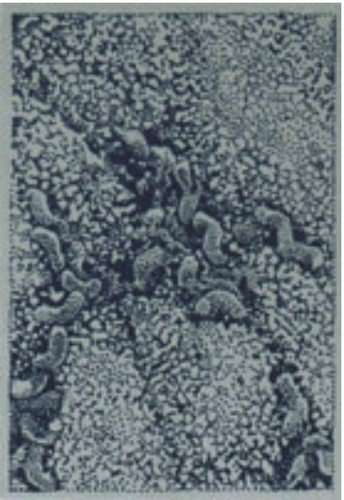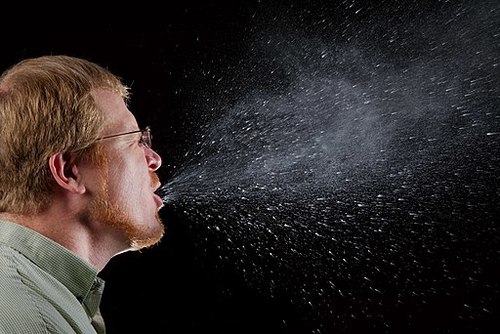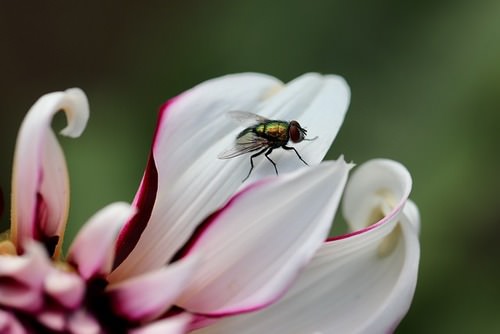11.15 细菌疾病 -- -- 先进
章节大纲
-
Would this worry you?
::你会担心吗?It should. This is Lyme disease. Lyme disease is caused by the Borrelia burgdorferi and needs appropriate medical treatment. If you're treated with the appropriate antibiotics in the early stages of the disease, you're likely to recover completely. In later stages, response to treatment may be slower, but the majority of people with Lyme disease do recover completely with the appropriate treatment. Left untreated, this can become very serious.
::这应该是莱姆病。莱姆病是由博丽莉娅·伯格多夫里引起的,需要适当的医疗。如果你在疾病的早期阶段就用适当的抗生素治疗,你可能会完全康复。在后期,治疗反应可能较慢,但大多数莱姆病患者确实通过适当的治疗完全康复。如果得不到治疗,情况会变得非常严重。Prokaryotes and Disease
::原虫和疾病For centuries people had no idea about the existence of microorganisms. The causes of were often blamed on misfortune, the displeasure of divine beings with humanity, or poisonous vapors from the sick and dead (miasma theory). The action of tiny, unseen organisms in the spread of disease was suspected but could not be proven. Ancient Indian and Persian texts discussed the role of tiny living things causing sickness and the control of such illnesses. In the mid 16 th century, Girolamo Fracastoro, an Italian physician, proposed that epidemic diseases are caused by tiny, transferable particles, or "spores," that could transmit infection by direct or indirect contact.
::几个世纪以来,人们对微生物的存在一无所知,其原因常常被归咎于不幸、人类对神灵的不满,或病人和死者的毒气蒸发(米亚斯马理论 ) 。 怀疑但无法证实小的、看不见的有机体在疾病传播中的行为。 古印度和波斯文文讨论了小生物的作用,它们造成了疾病和控制这些疾病。 16世纪中叶,意大利医生吉罗拉莫·弗拉卡斯托罗(Girolamo Frascatoro)提出,传染病是由小的、可转移的微粒或“呼吸器”造成的,它们可以通过直接或间接接触传染。Microorganisms were first directly observed by Anton van Leeuwenhoek, in 1676. But the connection between microbes and disease was not scientifically proven for another 200 years. A German physician, Robert Koch, became famous for showing that the disease anthrax was caused by the bacterium Bacillus anthracis. In 1890, he became the first scientist to offer proof that bacteria cause infectious disease. Koch’s discoveries are now known as the Germ Theory of Disease.
::1676年,Anton van Leeuwenhoek首次直接观察了微生物。 但微生物和疾病之间的联系在科学上再有200年没有得到证实。 德国医生Robert Koch(Robert Koch)以表明炭疽病是由细菌炭疽杆菌引起的而闻名。 1890年,他成为第一位提供细菌导致传染病证据的科学家。 Koch的发现现在被称为“疾病格伦理论 ” 。Pathogens
::病原体As stated earlier, it is estimated that up to 100,000 of live in the (The estimate is a wide range, from 500 to 100,000). Prokaryotic cells are much smaller than human , and there are about ten times as many prokaryotic cells as human cells in the body (estimated at 1,000 trillion prokaryotic cells versus 100 trillion human cells). Much of the body’s of prokaryotes, the body’s “normal flora,” is found on all surfaces exposed to the environment (on the skin and , in the mouth, nose, , and large intestine). The majority of these bacteria live inside the body, in the . Many of these are harmless, but a few can cause disease.
::如前所述,据估计,在(估计值从500到100,000不等的)活体中,估计有多达10万个活体。 普罗卡利细胞比人类小得多,并且有大约十倍于人体细胞(估计为1,000万亿个蛋白细胞和100万万个人类细胞 ) 。 大部分身体的prokaryotes,即身体的“正常植物 ” ( 正常植物 ) , 都出现在暴露于环境的所有表面(皮肤和口腔、鼻鼻和大肠 ) 。 这些细菌大多存在于人体内部,其中有许多是无害的,但有少数可以引起疾病。An infectious disease is a disease that is caused by pathogenic microrganism, including bacteria, , , , and multicellular parasites . A is an organism that causes disease or illness to its host . Pathogens can infect both unicellular and from all of the biological kingdoms. There are several ways in which bacterial pathogens can get into a host. In humans, soil contamination of a wound, bacterial contamination of food , and contact with infected bodily fluids are some common modes of infection. The body contains many natural defenses against some common pathogens:
::传染病是一种由病原体微生物,包括细菌、细菌和多细胞寄生虫引起的疾病。A是给宿主造成疾病或疾病的有机体。病原体可以感染非锥体和来自所有生物王国的病原体。细菌病原体可以通过几种方式进入宿主。在人类中,伤口的土壤污染、食物的细菌污染和接触受感染的体液是某些常见的感染方式。身体含有许多针对一些常见病原体的自然防御:-
The skin, which acts as a physical barrier to microorganisms.
::皮肤是微生物的物理屏障。 -
The population of commensal (helpful) bacteria that live in the intestines.
::生活在肠子里的同族(有帮助的)细菌群。 -
The
immune system
(including
white blood cells
and antibodies).
::免疫系统(包括白血细胞和抗体)。
If pathogenic bacteria get past these defenses, they can cause infection and disease. An infection is the colonization of a host organism by a pathogen. In an infection, the infecting organism aims to use the host's resources to feed and replicate themselves. Generally the host is harmed because the pathogen interferes with in the host. This imbalance can lead to inflammation, chronic wounds, poor health, and even death.
::如果病原体细菌通过这些防御,它们就可能造成感染和疾病。 感染就是病原体对宿主生物的殖民化。 在感染中,感染有机体的目的是利用宿主的资源喂养和复制自己。 一般来说,宿主受到伤害是因为病原体干扰宿主。 这种不平衡会导致炎症、慢性伤口、健康状况不佳甚至死亡。If the body’s homeostatic balance get damaged, by getting a large or deep wound, killing off gut bacteria with antibiotics, or reducing the numbers of white blood cells (such as in an infection with HIV), pathogenic bacteria have a chance to grow and cause harm to the host. Bacteria that infect the body when the body’s defenses are weakened cause infections known as opportunistic infections.
::如果人体的顺势平衡因大伤或大伤、用抗生素杀死直肠细菌或减少白血细胞(如感染艾滋病毒)而受损,病原体细菌就有机会生长并伤害宿主。 当人体防御能力减弱时感染人体的细菌会引发被称为机会性感染的感染。Pathogenic bacteria are a major cause of human death and disease; they cause infections such as tetanus, typhoid fever, diphtheria, syphilis , cholera, food-borne illness, leprosy, and tuberculosis . A pathogenic cause for a known medical disease may only be discovered after many years of research. This was the case with the link between Helicobacter pylori, shown in Figure , and peptic ulcer disease. Bacterial diseases are also important in , with bacteria causing leaf spot, fireblight, and wilts in plants, as well as Johne's disease (diarrheal disease in cattle), mastitis (infection of milk ducts), and anthrax in farm .
::病原细菌是造成人类死亡和疾病的主要原因;它们造成诸如破伤风、伤寒、白喉、梅毒、霍乱、食物传染疾病、麻风病和肺结核等传染病,已知医疗疾病的病原原因只有在经过多年研究后才能发现,图中显示的甲状腺素与甲状腺素疾病之间的联系就是这种情况。细菌疾病在细菌引起叶片、火光和植物枯萎以及强氏病(牛中的腹泻病)、马氏病(牛奶管感染)和农场炭疽病中也很重要。A scanning electron micrograph image of Helicobacter pylori bacteria attached to human stomach cells. H. pylori bacteria are able to withstand the low pH of stomach acids because they secrete an enzyme that neutralizes the acid. Before H. pylori was linked to peptic ulcers, doctors blamed stress and spicy foods for many ulcers. Transmission of Disease
::疾病传播的疾病An infectious disease is also called a contagious diseases (or communicable disease ) when it can be passed from one person to another or from one species to another. Transmission of an infectious disease may occur through physical contact with infected individuals, through liquids, food, body fluids, contaminated objects, airborne inhalation, or spread by a vector . A vector is an organism or an object that does not cause disease itself, but which spreads infection by spreading pathogens from one host to another. Some common vectors of disease are shown in Figure . Table lists some contagious bacterial diseases and their modes of transmission and treatments.
::传染病也可以称为传染病(或传染性疾病),如果这种疾病能够从一个人传到另一个人,或从一个物种传到另一个物种,传染病的传播可以通过与受感染者的身体接触,通过液体、食物、体液、受污染物体、空气吸入,或由媒介传播,媒介是一种不引起疾病本身的有机体或物体,但通过把病原体从一个宿主传到另一个宿主传播而传播感染。-
Edit here for caption
::编辑此标题 -
Edit here for caption
::编辑此标题 -
Edit here for caption
::编辑此标题 -
Edit here for caption
::编辑此标题
Transmission of diseases may happen in different ways. Respiratory diseases, such as the common cold, are commonly caught by contact with droplets in the air, which are spread by sneezing or coughing. Respiratory and gastrointestinal illnesses can also be spread through contact with surfaces that many people touch, such as drinking fountains or computer keyboards. Gastrointestinal diseases can be spread by flies. Even our beloved pets can be vectors of diseases, as they tend not to be too concerned about what they chew on. Contagious Bacterial Diseases Bacterium Disease Mode of Transmission Treatment Escherichia coli Urinary tract infection, peritonitis, foodborne illness Fecal-oral route, through contaminated food or Antibiotics for about 10 days to 2 weeks Mycobacterium tuberculosis Tuberculosis Aerosol droplets from a sneeze, cough, or spit Antibiotics for 6 to 12 months Campylobacter jejuni"
::野兽JJJONI"Campylobacteriosis (diarrhea, cramping) Fecal-oral route, through contaminated food or water Antibiotics are not normally used, disease is usually self-limiting Salmonella
::鲑鱼- (Numerous disease-causing species)
Gasteroenteritis: diarrhea, fever, vomiting, and abdominal cramps Fecal-oral route, through contaminated food or water Antibiotics are not normally used, disease is usually self-limiting. Intravenous fluids if dehydration occurs Staphylococcus aureus (Methcillin Resistant—MRSA) Skin abscesses, can lead to sepsis and toxic shock syndrome Asymptomatic carriers; can be picked up and infect wounds (e.g. turf burns), sharing of personal hygiene products (razors, towels). Prevention: frequent hand-washing, alcohol hand sanitizers. Wound care and cleaning, antibiotic treatment: vancomycin Streptococcus pyogenes Group A streptococcal infections: strep throat; scarlet fever. All severe GAS infections may lead to shock, organ failure, and death. Asymptomatic carriers; infection can occur when immune system is depressed Antibiotics, such as penicillin Helicobacter pylori Stomach ulcers Asymptomatic carriers, spread among people in close contact Antibiotics Bacillus anthracis Anthrax B. anthracis may be inoculated into a wound, inhaled, or ingested Antibiotics such as penicillin Summary
::摘要-
Bacteria can cause disease in two ways: by physically growing and invading tissues and cells or by releasing toxins into the body.
::细菌可通过以下两种方式造成疾病:身体生长和侵入组织和细胞,或向身体释放毒素。
Review
::回顾-
Identify two different ways that bacteria can cause disease in the body.
::找出两种不同的方式 细菌在身体中引起疾病
-
The skin, which acts as a physical barrier to microorganisms.





